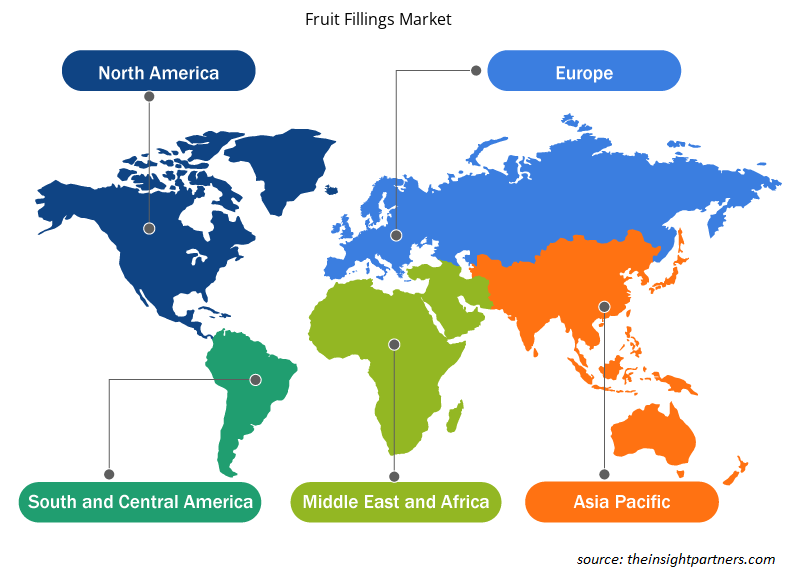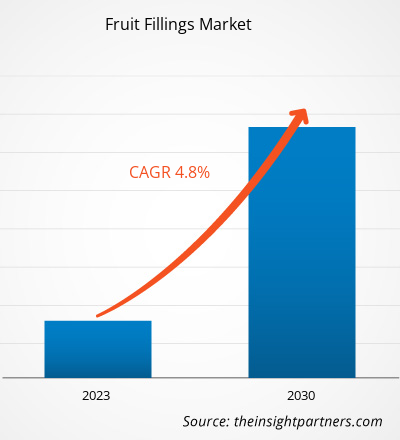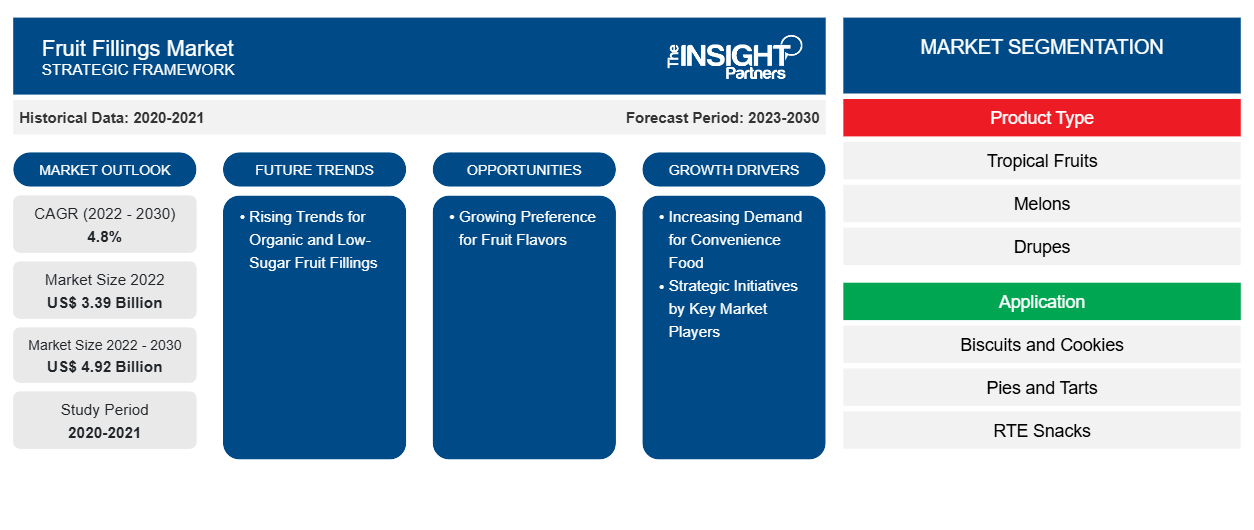[研究报告] 水果馅料市场规模预计将从 2022 年的 33.8685 亿美元增长到 2030 年的 49.2415 亿美元;预计 2022 年至 2030 年市场复合年增长率为 4.8%。
市场洞察和分析师观点:
水果馅料业务是食品行业中一个充满活力且多样化的细分市场,其特点是产品、应用和消费者偏好范围广泛。随着人们越来越关注天然和健康食品的选择、可支配收入的增加、饮食习惯的改变以及食品加工行业的蓬勃发展,对水果馅料的需求持续上升。消费者对清洁标签和天然成分的倾向是水果馅料市场的主要驱动力。随着注重健康的消费者群体的不断增长和对食品成分认识的提高,人们越来越倾向于由真正的水果成分制成的水果馅料,而不含人工添加剂或防腐剂。这种水果馅料市场趋势在北美和欧洲等发达市场尤为明显,这些市场的消费者愿意为高品质的天然产品支付高价。
方便食品的流行推动了对水果馅料的需求,因为它们被广泛用作各种即食食品和便携零食的配料。水果馅料在增强馅饼、糕点和松饼等烘焙食品和巧克力、糖果和水果棒等糖果产品的风味和质地方面起着至关重要的作用,同时还能提供一股天然的甜味。快速的城市化、可支配收入的增加和饮食习惯的改变是推动亚太地区、南美洲和中美洲新兴经济体水果馅料市场发展的其他显著因素。随着这些地区越来越多的消费者采用西方饮食和生活方式,对含有水果馅料的烘焙、糖果和乳制品的需求也在增加。此外,这些地区有各种热带和异国水果供应,为产品创新和风味实验提供了机会。然而,水果的季节性供应和原材料价格的波动阻碍了水果馅料市场的增长。
增长动力和挑战:
全球各地的水果馅料制造商都在积极参与并购、合作和其他战略发展,以吸引消费者并提升其市场地位。2022 年 5 月,Puratos 宣布收购丹麦领先的水果馅料公司之一 Give Konfekture。此次收购旨在扩大其地理覆盖范围。此外,制造商还致力于扩大其产品范围,以满足对水果馅料的高需求。例如,2022 年 10 月,Puratos UK 宣布收购 Fourayes,后者是英国最大的水果加工商和商业果酱制造商,产品包括面包店、甜点和乳制品。Puratos UK 旨在通过此次收购巩固其在水果馅料市场的地位。
市场上的一些主要参与者也参与了产品发布和产品开发,以满足客户对不同类型水果馅料日益增长的需求。2023 年 11 月,Puratos USA 宣布推出由 Honeycrisp 和 Granny Smith 苹果制成的全新新鲜苹果派馅料。馅料融合了甜味和酸味,口感酥脆。此次发布旨在满足对水果馅料日益增长的需求。因此,主要市场参与者的战略举措推动了水果馅料市场的增长。
然而,不同类型的水果,如热带水果、瓜类、核果类和浆果类,都被用作制造水果馅料的原料。其中一些水果是季节性的,用这些水果制成的水果馅料很大程度上依赖于它们的季节性供应。草莓、覆盆子、芒果和其他水果的生长季节有限,一年中只有特定时期供应。这可能导致季节性水果供应中断,从而导致供需缺口。
定制此报告以满足您的需求
您可以免费定制任何报告,包括本报告的部分内容、国家级分析、Excel 数据包,以及为初创企业和大学提供优惠和折扣
-
获取此报告的关键市场趋势。这个免费样品将包括数据分析,从市场趋势到估计和预测。
报告细分和范围:
“2030 年全球水果馅料市场分析”是一项专业而深入的研究,主要关注市场趋势和增长机会。该报告旨在提供市场概述,并按产品类型和应用对市场进行详细细分。市场在最近经历了高增长,预计在预测期内将继续保持这一趋势。该报告提供了全球水果馅料消费的关键统计数据。此外,全球水果馅料市场报告对影响全球市场表现的各种因素进行了定性评估。该报告还包括对市场主要参与者及其关键战略发展的全面分析。还包括对市场动态的几项分析,以帮助确定关键驱动因素、市场趋势和有利可图的机会,进而有助于确定主要收入来源。
水果馅料市场预测是根据各种二手和一手研究结果(如主要公司出版物、协会数据和数据库)估算的。此外,生态系统分析和波特五力分析提供了对市场的 360 度视角,有助于了解整个供应链和影响市场表现的各种因素。
节段分析:
水果馅料市场根据产品类型和应用进行细分。根据产品类型,市场分为热带水果、瓜类、核果类、浆果类和其他。2022 年,浆果类占据了水果馅料最大的市场份额。预计 2022 年至 2030 年期间的复合年增长率最高。近年来,对蓝莓和覆盆子等浆果的需求越来越大。草莓、蓝莓和覆盆子以其鲜艳的色彩、独特的风味和健康益处而闻名。消费者越来越多地寻求新鲜和天然甜味的产品,这推动了对浆果在各种应用中的需求。浆果富含维生素、纤维和抗氧化剂,引起了消费者对更健康食品选择日益增长的兴趣。随着消费者优先考虑自己的健康,在水果馅料中加入浆果符合对放纵和营养选择的需求。浆果的多功能性是促进其作为各种应用的水果馅料使用的关键因素,包括蛋挞、馅饼、饼干、曲奇和冷冻甜点。
区域分析:
市场范围集中在五个关键地区——北美、欧洲、亚太地区、中东和非洲以及南美和中美洲。2022 年,欧洲占据了最大的水果馅料市场份额,市场价值约为 10,450 亿美元。在欧洲,水果馅料需求的激增可以归因于该地区丰富的烹饪传统,以及对优质和手工产品的日益增长的偏好。根据一项研究,2022 年,羊角面包占欧洲维也纳甜酥面包总消费量的 50%。欧洲消费者欣赏传统美食的高品质和多样化风味,而水果馅料提供了一种将这些风味注入各种食品的便捷方式。这种对优质、美味食材的文化倾向导致欧洲对水果馅料的需求不断增加。此外,对可持续性和本地采购食材的重视已成为欧洲水果馅料的重要驱动力。欧洲许多消费者开始担心他们选择的食品对环境的影响,因此更倾向于选择由当地种植的水果制成的产品。水果馅料产自当地,通常以可持续性为重点制作,这与欧洲消费者对环保和道德食品选择日益增长的兴趣相一致。
预计 2022 年至 2030 年,亚太地区的复合年增长率将超过 5.7%。亚太地区发展中经济体正在经历快速经济增长,制造公司数量激增,有组织的零售和服务业大幅扩张。这得益于人口增长、有利的政府法规、自由贸易政策、丰富的资源以及廉价的劳动力和制造设施。此外,亚太地区水果馅料市场的主要参与者包括 PURATOS、AGRANA Beteiligungs-AG 和 Barry Callebaut。这些公司正在采取各种战略举措,如创新和新产品开发,以满足不断增长的需求。2019 年,AGRANA Beteiligungs-AG 在中国建立了水果产品生产基地,对新工厂投资 2663 万美元。
水果馅料市场区域洞察
Insight Partners 的分析师已详细解释了预测期内影响水果馅料市场的区域趋势和因素。本节还讨论了北美、欧洲、亚太地区、中东和非洲以及南美和中美洲的水果馅料市场细分和地理位置。

- 获取水果馅料市场的区域特定数据
水果馅料市场报告范围
| 报告属性 | 细节 |
|---|---|
| 2022 年市场规模 | 33.9亿美元 |
| 2030 年的市场规模 | 49.2亿美元 |
| 全球复合年增长率(2022 - 2030 年) | 4.8% |
| 史料 | 2020-2021 |
| 预测期 | 2023-2030 |
| 涵盖的领域 |
按产品类型
|
| 覆盖地区和国家 |
北美
|
| 市场领导者和主要公司简介 |
|
水果馅料市场参与者密度:了解其对业务动态的影响
水果馅料市场正在快速增长,这得益于终端用户需求的不断增长,这些需求源于消费者偏好的不断变化、技术进步以及对产品优势的认识不断提高等因素。随着需求的增加,企业正在扩大其产品范围,进行创新以满足消费者的需求,并利用新兴趋势,从而进一步推动市场增长。
市场参与者密度是指在特定市场或行业内运营的企业或公司的分布情况。它表明在给定市场空间中,相对于其规模或总市场价值,有多少竞争对手(市场参与者)存在。
在水果馅料市场运营的主要公司有:
- PT Hakiki Donarta
- 百乐嘉利宝公司
- 阿格拉纳保险股份有限公司
- 安德罗斯 SNC
- 欧元集团
免责声明:上面列出的公司没有按照任何特定顺序排列。

- 了解水果馅料市场的主要参与者概况
行业发展和未来机遇:
根据新闻稿,水果馅料市场主要参与者采取的一些举措如下:
- 2023 年 7 月,Puratos NV 与 Korabi Corporation 建立了战略合作伙伴关系,后者为科索沃供应烘焙和糕点原料。通过此次合作,该公司一直致力于为科索沃市场提供创新和高品质的烘焙和糕点解决方案。
- 2021 年 3 月,Dawn Foods 宣布收购 JABEX(波兰别尔斯克-比亚瓦),这是一家家族企业制造商,专门为烘焙行业生产高品质水果制品。
竞争格局和重点公司:
PT Hakiki Donarta、Barry Callebaut AG、Agrana Beteiligungs AG、Andros SNC、EMU AG、Puratos NV、Toyota Tsusho Foods Corp、Zentis Fruchtwelt GmbH & Co KG、Orana AS 和 Dawn Food Products Inc 是水果馅料市场报告中介绍的主要参与者。全球市场参与者专注于提供高质量的产品以满足客户需求。
- 历史分析(2 年)、基准年、预测(7 年)及复合年增长率
- PEST和SWOT分析
- 市场规模、价值/数量 - 全球、区域、国家
- 行业和竞争格局
- Excel 数据集
近期报告
相关报告
客户评价
购买理由
- 明智的决策
- 了解市场动态
- 竞争分析
- 客户洞察
- 市场预测
- 风险规避
- 战略规划
- 投资论证
- 识别新兴市场
- 优化营销策略
- 提升运营效率
- 顺应监管趋势























 获取免费样品 - 水果馅料市场
获取免费样品 - 水果馅料市场